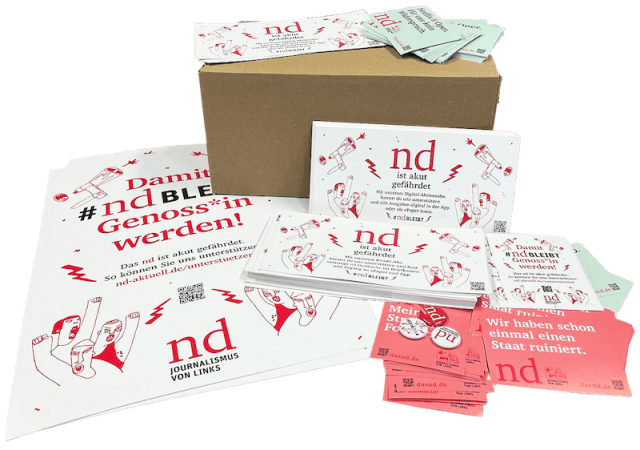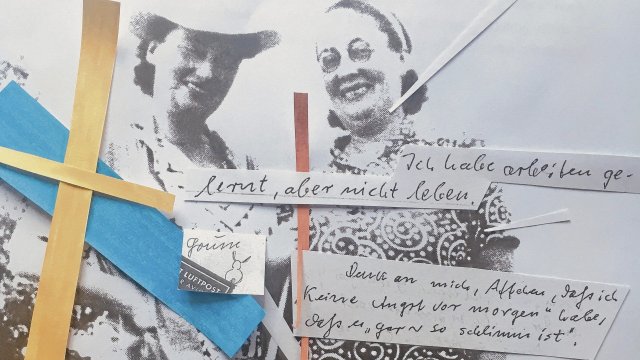Work in progress: the Laserstein sisters, seen through the research material
Photo: Maxie Jost/Vajswerk
You are both part of the research collective Vajswerk in Berlin, which develops “scenic realizations” on “socially relevant topics,” as it says on your website. One of your projects is about the Laserstein sisters, two German Jews, one of whom returned to Germany after National Socialism and the other who did not. Can you tell us something about that?
Laura Mitzkus: It’s about Käte and Lotte Laserstein, who both survived the Holocaust. The story goes like this: One sister, the artist Lotte, emigrated to Sweden when the Nazis began to exclude Jewish people. The mother of the two was deported to the Ravensbrück concentration camp and was also murdered there. Käte Laserstein, the teacher, went into hiding and survived the last years of the war with friends in a gazebo.
Christian Tietz: They were persecuted as Jews, and in the case of Käte Laserstein, she was also a lesbian, so she was exposed to additional danger.
Mitzkus: We have been accompanying these two women for several years now, now with the fourth project “back.stay”. In November 2022, for example, we focused on Käte’s time in the arbor. Previously we looked into the relationship between the two sisters because we had so many great letters from Käte Laserstein to her sister. It’s also a great way to get into everyday life.
Tietz: For our play “Laserstein’s Places” we looked for two actresses to portray these two sisters, the now famous painter Lotte Laserstein and her sister, who is two years younger, the teacher Käte Laserstein. We had previously done a project with an art class in their former school, where the students knew that the survivor had been a teacher at their school. We told the story of the two sisters from two points of view: On one side of the auditorium was Lotte Laserstein’s studio, on the other side was the school board and the lectern at which Käte Laserstein herself had spoken at the time. Authentic places.
As a research collective, they strive for a “dialogue between art and science”. What exactly does this way of working look like?
Mitzkus: We travel around, go to the historical places, to the birthplaces, or to where the crime, the murder, whatever happened, for example in our project “Great Cinema DDR”. Sometimes we find people in advance with whom we can talk directly on site. Sometimes it happens spontaneously, then we talk to people, contemporary witnesses in the villages and find out interesting things. And the historians sit down in the archives.
Tietz: Sometimes there is nothing at all, and then everyone takes part, including the actors – they themselves conduct the interviews with the people they will later portray.
I know situations like this from political education trips when contemporary witnesses tell their stories. But the Holocaust survivors I met, for example, are of course not telling their story for the first time, but rather presented a narrative with a very rigid, certainly psychologically necessary framework, the boundaries of which are very guarded. It is a great responsibility when someone brings up things that were not intended. Did you prepare for this?
Tietz: What we are always given credit for is that we approach the matter very seriously and responsibly. That we are not looking for an opportunity to put ourselves in the spotlight in any way. Rather, our first interest is a substantive one, an interest in a person who is not ourselves. And then the “instantaneity” of the theatrical moment creates something that makes you think you are seeing one character through another character. A kind of embodiment emerges. Sometimes it is closer, sometimes further away from the historical person. In the very first play we did as Vajswerk in 2015, two Holocaust survivors performed theater with two young people. The young people of today embodied the young people of back then.
What was your intention with this production?
Tietz: Of course it’s about imparting knowledge, about understanding what was back then – we tell stories that haven’t been told yet. But then we are also concerned with conveying emotions in a special way. On the one hand, this happens automatically, as it happens in the theater: we have a person in front of us who is acting something, telling something, appearing in front of us. But in our piece “The Game of Dina and Jovan” this also happened because the survivors were actually on stage with us. Basically, we have a special connection to the characters through what we find out through our research. This work creates a special emotional access. We’re not just dealing with any data or numbers, but with the stories that are contained in an exchange of letters, for example – in letters that perhaps only three or four people have read before us.
Mitzkus: It’s just not fictional. And I think that’s what makes the stories come alive, they bring you closer.
I think, documentary work is a great advantage for the critical content of a work of art – when you work with historical sources, you can’t completely avoid developing the work based on social realities. Were there any key questions that you asked yourself regarding the Lasersteins’ actions or decisions?
Tietz: Käte goes back to Germany in 1954, Lotte stays in Sweden. Why do you decide to return to Berlin and persecute the children of the formeris to teach? Why do you remain in exile as an artist? Do you come back to Germany every now and then, have you closed this German chapter, or do you start it all over again? There is more than one answer to these questions. And that’s why it’s nice that as an art project we’re exploring how we can make these different answers tangible.
So you go through different justifications?
Mitzkus: Yes. I was just thinking again about why I think this work is so good: because we don’t position ourselves. If you try to illuminate every little bit and corner, it will remain without comment or position. At the Berliner Ensemble, however, where I worked until 2013/14, only a single perspective was often shown.
Tietz: We neither say that this exact person is Käte Laserstein, nor do we say that that’s exactly how it happened. And we also give the audience this scope to show: It was like this – or like that – or maybe like that.
I understand what you mean about the different options for action. But you still position yourself politically simply through your choice of topics?
Mitzkus: Right.
Tietz: And if this topic is: Do you go back to Germany? What kind of country is this that we live in, that we were kicked out of? Käte Laserstein is a classic remigrant; she returned to a college in which many were members of the Nazi teachers’ association. The concept of remigration is now in all the news and in all minds. In addition, due to the events in Israel and Gaza, we have of course been in a completely different discussion since October – what being a Jew and being a Jew in Germany means.
This is another specific topic, the remigrants after the Nazis, who actually returned to a community of perpetrators. All of these events are becoming more and more distant – and the survivors of the Holocaust have now almost all died.
Tietz: That’s right. But what is now resurfacing due to the current anti-Semitism, which has been latent for all these years and is now suddenly there again?
Interview
Laura Mitzkus studied acting at the Max Reinhardt Seminar in Vienna, Christian Tietz is a theater scholar and historian. The above-mentioned working methods of the Vajswerk research collective are supplemented by cultural education projects in which young people search for biographical traces and develop their own pieces using their results and impressions. You can find out more at: www.vajswerk.de
#ndstays – Get active and order a promotional package

Regardless of whether it is pubs, cafés, festivals or other meeting places – we want to become more visible and reach everyone who values independent journalism with an attitude. We have put together a campaign package with stickers, flyers, posters and buttons that you can use to get active and support your newspaper.
To the promotional package
sbobet judi bola online sbobet judi bola online
